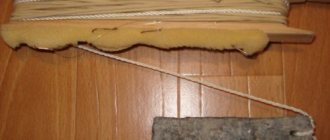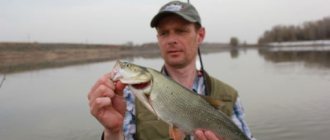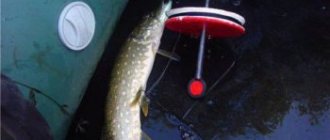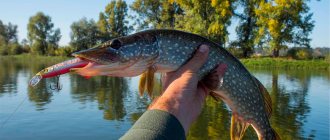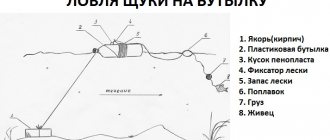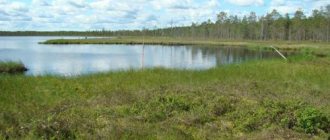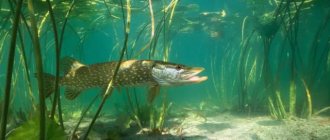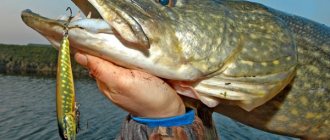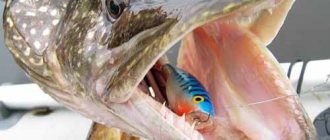In winter, all fish become inactive, and therefore go under the ice, where oxygen access is limited. But fishing for pike in January gives good results, since it does not particularly resist when fished. In this article you will learn where and how to fish and, more importantly, catch pike in the winter, in January, using a jig, spoon, and balancers.
Choosing a fishing spot
Fishing is generally dependent on the weather in any month of the year. You'll have to figure out when to catch pike and when not to.
- If the sky is cloudy, there is no wind and, on top of everything else, it’s snowing, this is the best time to catch a predator;
- On a frosty and sunny day, the fish is unlikely to swim out of its hole;
- During a north wind, fishing will not be successful.
Before fishing, you should always check the pond for the presence of fish. Usually the pike tries to stay in the pits throughout January, and leaves its place only during the period of hunger. And to catch this fish, you need to know its behavior and way of life.
An article about how to choose the ideal time and place for pike fishing.
In January, pike bite on the following gear:
- glitter;
- balance;
- girder;
- fishing rod;
- crab.
For example, for pike fishing, various fishing rods are used, both simple and sophisticated. The thickness of the line should be 0.2-0.3 mm.
It should be noted that in January, pike are picky about bait, and even an artificial one may not be interested in it.
Recommendations for where to fish for pike include the following:
- You should not look for this fish near the shore, as with the arrival of winter it tries to swim deeper into the reservoir.
- You can find pike in deep holes and pools.
- It is best to try to drill a hole in the middle of the reservoir, because predatory fish believe that the middle is the deepest place in the water.
- Using echo sounders makes it easier to find fish. True, they will not be cheap.
- You can try the survey method, that is, ask local fishermen. Is there pike here or not?
- Drilling several holes at once to check for the presence of fish in different places.
Pike behavior in January
One of the important factors influencing the behavior of a predator is changes in weather conditions.
- The fish sluggishly takes bait and stands in one place for a long time.
- Having seen a live bait, the pike may stand motionless near it and not see it. Therefore, it is necessary to make sharp movements up and down in order to provoke her to attack.
- In an open, windswept reservoir, the predator sinks to the bottom, and nothing good can be expected from fishing. However, when a warm wind blows from the south, the fish may come to the surface.
- Cloudy weather is more productive for fishing in winter.
- During the thaw, the pike becomes more active and feels hungry. The bait can serve as a signal for her. Everything is due to the fact that in winter she is accustomed to the cold, and when the weather warms up her activity increases.
- Moderate pressure without hesitation also has a good effect on the behavior of the predator. If the pressure fluctuates, then fishing should be postponed to another week.
Selection and equipment of the girder
There is a wide variety of girders, the design of which can be supplemented depending on the characteristics of the gear. They are divided into the following types:
- The vent is on a wide base. This type of gear is one of the most popular among fishermen.
- Zherlitsa on legs. It has proven itself very well on a hill of snow cover.
- Gear on the rail. It is considered compact among other types and easy to manufacture.
- Changeling on legs. It is not as reliable as we would like due to the fact that the fishing line is poorly wound and fixed in a snowy place.
- Subglacial vent. Used during night fishing, as well as when fishing for pike and burbot.
The most effective type is the one with a wide base. Its advantages are:
- Efficiency of use;
- Simplicity;
- Versatility;
- Small price.
When rigging, you must follow the following rules:
- An equally important point when fishing is the equipment of the girder. The whole trick is that you need to know exactly the depth of the reservoir and the length of the fishing line, which should be at least 300 meters made of monofilament with a diameter of 0.40 mm.
- It can be noted that having a nylon line is ineffective because it becomes rough. A thin line reduces strength, making it convenient to catch even large fish. It is better not to use braided cord, as it absorbs water and freezes in the cold.
- When equipping a girder, it is important to properly equip it and secure the sliding sinker. The sinker is shaped like an olive and should be placed on the cord just above the leash. The weight of the sinker will depend on the depth and strength of the current in the fishing area. If the weight is large, the pike will resist when biting, and may also become frightened by this and abandon the live bait.
- It is best to choose a girder with a flag that goes up. But here you need to focus on the behavior of the pike. Since the expectation of a bite is unpredictable, the alarm will help you quickly identify it. In addition, when the girder is activated, the fisherman will have time to prepare for the selection of the desired fishing line and carry out the hooking. Then you can start landing fish.
- In January, pike passively reacts to live bait and can stay near it for a long time while the fisherman is fishing with a lure. And it will be equally important to check the vent for 10-15 minutes, lifting it to a height of 50 centimeters. This action will provoke the fish to attack the bait.
Video guide on how to equip a girder , simple and accessible:
Fishing with a girder is work at depth. It is important to observe several nuances:
- In summer, fish are accustomed to swimming into deep holes, where they seek coolness, and in winter, they look for warm places.
- The use of echo sounders greatly helps in finding fish, but their cost may not suit every self-respecting fisherman.
- The use of several girders is also practiced among amateurs. Thus, they increase the chances of catching. But the presence of many girders makes it difficult to catch a pike, since you may not be able to catch one or another tackle in time.
- You also need to take into account that pike loves snags or places containing large stones.
- In the winter season, girders should be placed in places where a stream or spring flows into a body of water. This is where pike and other large fish are most often found.
crucian carp
The most commonly used live bait when fishing for pike is crucian carp (photo 3). And, I think, not only with us. Because it is relatively easy to catch such live bait yourself, and in fishing stores crucian carp is found much more often than others and is cheaper. But the most important thing is that it is very difficult for a pike to pick off a crucian carp set behind the back due to the dense and bony meat in which the hook sits securely.
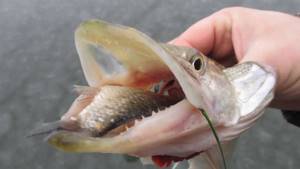
Photo 3
I remember one unusual method of catching live bait, which can be adopted during the period of first ice. The pond where I fished for pike during my school years had a fairly large but shallow bay. When frosts began, this bay was the first to be covered with ice. By autumn its depth was less than knee-deep. And it was here, on this shallows, that the crucian carp, the size of an index finger, miraculously survived over the summer, hid from the pike’s teeth.
When the young ice could already support a person, but at the same time sagged and cracked, we came here with axes and cut small holes. After that, we simply stomped between the holes in such a way that water flowed out of them onto the ice. Along with the flow of water, there were also crucian carp on the ice, which had to be collected before they swam back into the hole. The live bait obtained in this unusual way was just enough for several fishing trips on the first ice.
And crucian carp are not at all picky about storage conditions. With us, they feel comfortable in a tank of water, even without turning on the aerator. And in the store where we buy live bait, they are generally stored on the shelves of the refrigerator in small plastic containers, and the density of the fish is like that of sprat in cans.
Crucian carp are very tenacious, and when hooked correctly, they remain active for several days. Sometimes crucian carp do not die even after several pike bites - this fish is so resilient! It also happened that after an unsuccessful girder fishing, we removed the failed crucian carp from the gear, brought them home - and they lived quietly for a week or two until the next fishing, even with pierced backs.
In general, crucian carp could be called an ideal live bait, if not for one “but”. Despite the fact that this fish is quite widespread, and it is difficult to find a body of water in which crucian carp is not found, pike are not readily caught with it everywhere. According to our observations, the spotted predator is good at catching crucian carp only soon after the ice has formed, when it begins to eat. In the second half of winter, when the bite becomes noticeably worse, pike respond well to crucian carp only under favorable conditions - for example, during prolonged thaws, when its appetite improves. The rest of the time it is better to offer her another live bait.
Here is an example from last winter. At the end of February - beginning of March, the pike bite in our area is very strongly tied to the evening and morning dawn, when several bites in a row can happen in the deep twilight, but during the day you may not even wait for the flag to rise. Therefore, we use under-ice structures of vents (so-called supply structures), leaving them overnight.
One day we set up our fishing rods in the bay, where another fisherman also placed flags. We used crucian carp as live bait, and in the morning we did not find a single triggered bait. But the neighbor took several large pikes from his fishing rods that had caught roaches. According to him, he has long noticed that closer to spring the pike almost does not take crucian carp. Therefore, he is not lazy to travel two dozen kilometers to the neighboring Volga Bay, where small roach are caught well. Such time expenditure is fully justified.
And another typical example. That fishing took place on the pond in mid-January. We set up 8 zherlits, loaded them with crucian carp brought from home. The pike didn't take it, and we decided to catch local bait fish. After much torment, we persuaded one palm-sized perch. It was a bit large for a pike, but there was nothing to be done - they baited one girder with it. And it was on this tackle that the only bite that occurred all day was a pike over a kilogram. Alas, it was not possible to catch any more local live bait, and the pike flatly refused to bite on crucian carp.
And one more main disadvantage of crucian carp: despite the fact that the fish remain alive on the hooks of the girders for a long time, they very quickly lose their motor activity - and hang completely motionless on the tackle. Perhaps this is why pike take them poorly? When we fish with crucian carp, we go around the girders from time to time, lightly tugging on the line and forcing the crucian carp to move. Very often, immediately after such rounds, bites occur (photo 4).

Photo 4
How to make a zherlitsa with your own hands

To prepare your own zherlitsa you will need:
- Fishing line . Because it is less exploited, the company should not worry. Its diameter will depend on the size of the fish. Usually take up to 0.6 mm.
- Reel _ About 20 meters of fishing line are wound on it - maybe a little more.
- Leash . It is often made of metal so that predatory fish cannot bite it.
- Sinker . Its weight should have a ratio to fish of 1:2. On the river, the load is chosen depending on the speed of the current (it is important that the live bait is kept in one place).
- Alarm.
- Hooks.
- Bright flag.
Installation of the vent is carried out as follows:
- Wind the fishing line onto the girder. The length of the fishing line should be approximately 15 meters (it is always better to take it with a reserve);
- Line diameter from 0.3 to 0.5 mm (the choice will depend on the size of the fish);
- Using a leash. Usually taken from nichrome or tungsten. The length of such a leash should be about 15 centimeters;
- It is important that the sinker matches the strength of the current. When loading, the main thing is to hold the bait and not allow it to float to the surface or swim away into the thickets. The load should be round in shape so that there is no overlap of the fishing line;
- Single or triple hooks are used;
- The flag should be triggered in such a way that when there is a bite, it rises up.
Live bait size
My passion for fishing in winter with lures began in school. And an excellent training ground for this turned out to be a rather large and deep pond that surrounded our village like a horseshoe. The pond was literally filled with pike, and there were specimens weighing 5 - 7 kg. But in just a few years of my practice of girder fishing, the voracious pike managed to eat all the local crucian carp, so only the round, plate-like hulks of crucian carp from half a kilogram and above were adjacent to the toothy one.
But bait-size crucian carp are hard to find during the day. It was necessary to stock up on live bait in advance, and this was a very troublesome task. While it was still warm in the autumn, on weekends I rode a bicycle to a steppe pond located several kilometers from the village. There were no pike in it, but palm-sized carp were found in abundance. They were excellently caught with a float rod until the onset of cold weather, and two or three trips to that pond were enough to stock up on crucian carp in abundance. I planted them in a large barrel, which was located in the basement of the house, and changed the water to fresh water once a week.
I didn’t feed the fish with anything, because... When feeding, the water turned sour very quickly - and it had to be changed many times more often. But even without feeding, the crucian carp felt great, the mortality rate was very small, and the fish caught were quite enough for the first half of winter. In February, the wilderness set in, fishing conditions became more difficult, and the pike bite deteriorated significantly, so fishing with girders stopped. But with other fishermen I knew, crucian carp, stored in the fall, survived until spring under the same storage conditions.
Nowadays it’s much easier with live bait - any self-respecting fishing store always has live fish in stock, and sometimes even in a wide variety. Moreover, on the roads leading to the most popular pike reservoirs, retail outlets have recently appeared that sell fishing goods, including live bait, around the clock. It’s very convenient: when you go fishing, you buy fresh and lively bait. And you don’t have to bother with storage or worry that the live bait will fall asleep on the eve of going to the reservoir or won’t survive the long journey.
But my wife and I adhere to a simple rule: stock up on live bait on the eve of fishing in advance, and not at the last moment. And if fishing is planned for Saturday, then we buy live bait on Wednesday or Thursday, because even on Friday evening, live bait tends to “unexpectedly” run out. Well, about three dozen fish calmly wait for a couple of days on the loggia in a 60-liter plastic tank (photo 2). Once a day we change their water to fresh water, and, as needed, turn on the aquarium aerator, which pumps in fresh air.
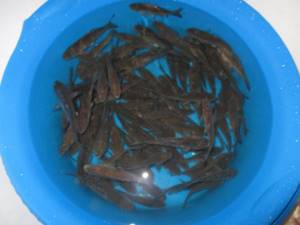
Photo 2
And a long time ago we abandoned the preparation of live bait at the fishing site. Although there is a rule that a predator takes best on the live bait that lives in the same body of water with it. There is a rule, but it’s not always possible to follow it. It’s good if you managed to arrive at the pond before dawn, and the small fish began to bite immediately, without being capricious. But such favorable conditions rarely develop, and you have to spend a long time looking for holes in which you find a fish of the required size, entice it with bait, and persuade each specimen to bite.
The canal is filled with live bait very slowly, the pike bite time is running out inexorably, and the bait baits haven’t even been placed yet... How many times have we found ourselves in such a situation when bait fishing was ruined due to the fact that the candidate for live bait was on strike! Therefore, now we come to pike reservoirs with purchased live bait, set up the girders, and only then catch local fish, and make replacements as necessary.
Our rating of pike baits
Other fishing methods
There are several fishing methods:
- For the spinner;
- On the crab;
- To the girder;
- To the balancer.
If in January the water bodies in your region are not covered with ice, then you can catch pike using a spinning rod.
The method of fishing with a zherlitsa is considered successful, although another method of fishing may be preferred.
Fishing for pike with lures in January will not produce as many fish as, for example, a girder. It all has to do with:
- There is no practice of high-quality placement of the spinner;
- The bait is lowered vertically into the hole and imitates the movement of the fry, which provokes the pike to grab it;
- The pike immediately recognizes the spinner, and when fishing, it can figure it out and throw the bait.
The fish bite in January is weak, but does not stop. It should be noted that pike are reluctant to accept artificial baits.
The most active hours when you can catch pike are in the morning or at noon. Less often, she begins to hunt in the evening and then at the time of the thaw.
Fishing with a balance beam or spoon is carried out according to the preference of the angler. The main thing here is what you like best. But it should be noted that even the best gear may turn out to be ineffective, since the pike can easily bite through it. Everything will depend on the fisherman’s reaction to the bite.
To fish with a balance beam, you need to find a fishing spot in advance. And to do this, you need to understand its behavior not only in spring, summer and autumn, but also in winter. It is best to choose a proven body of water, because in an unfamiliar place it will be difficult to figure out whether the pike is hiding in the depths or in the shallows.
There are the following techniques for fishing with a balance beam:
- Lower the bait to the bottom and after a few swings move to a higher place;
- Start working from the surface and move towards the bottom.
Lure fishing
To catch pike you need to choose certain lures.
The emphasis should be on their thickness. This is explained by the fact that a pike may not be able to see a very thin fishing line, but will immediately pay attention to a large fishing line. The hook must be carried out instantly, without hesitation. If the fish manages to understand that the prey is artificial, it will spit it out and swim away. The choice of spoon depends on the preference of the angler. Of the most catchy spinners, choose the following:
- Type A. Made of stainless steel, filled with lead and solder. The shape is oval and equipped with triple hooks. The length of such a spinner is approximately 80 mm and weighs 33 grams. Slowly sinks into the water and maintains a moderate oscillation rhythm. There is a winding ring here that is used as a release mechanism when the bait gets caught on snags. It helps reduce line breakage under load.
- Type B. Used as an oscillator. The shape is similar to a curved knife. Length 80 mm and weight 25 grams. Made from convex stainless steel, filled with lead and solder. It has such a game that the predator rushes at the prey without hesitation. Works well in shallows and shallow depths.
- Type B. Has a flat appearance with a large arch. Reminds me of a ski. The spinner is 75 mm long and weighs 16 grams. Used for fishing in lakes and reservoirs where there is a weak current. Its diameter is 0.3 mm. This lure can be used to fish from shallows and at depth. They are easily immersed in water and rotate moderately from side to side. Excellent play at different speeds when rising and falling.
- Type G. Made from a convex brass plate with solder inside. It is 65 mm long, 15 mm wide, and weighs 7 grams. The center of gravity is shifted to the head, which in turn gives such a spinner significant mobility. It differs from other spinners in its quiet play.
Detailed article about fishing for pike with a spoon.
To the balancer
This bait has no drawbacks. When it is clear that the pike is not being taken to the balance beam, it means that the bait has not been assembled correctly. She may be:
- Bright or dim;
- Big or small.
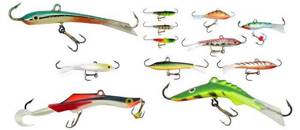
You need to choose the right balancer for a certain body of water in order to observe bites. Everything will depend on the time of year and day.
How to choose the best bait for pike.
The advantages of a balancer for pike fishing in winter include:
- When catching a predator in winter with live bait, artificial bait is suitable. Since catching live bait takes a lot of time, it is easier to buy ready-made bait in the store.
- You can influence the behavior of the bait underwater. With the use of a balancer, fishing becomes predictable.
- You can control the balancer yourself.
- Compared to girders, you can catch more fish with a balancer, since predators like to attack this bait.
Ice fishing
In January, in most regions, fishing is carried out from ice. Low temperatures also reduce the activity of fish, which is why gear for winter fishing is made thinner. They are collected based on different types of fishing:
| type of fishing | line thickness |
| zherlitsa | from 0.25 mm to 0.4 mm |
| fishing on a balance beam | 0.18-0.22 mm |
| lure fishing | 0.16-0.2 mm |
| fishing with rattlin | 0.16-0.22 mm |
| fishing with silicone | 0.2-0.22 mm |
An important point is the choice of base; a special fishing line with the designation “Ice” is suitable for this. You can also use a cord, but preference should be given to options with anti-freeze treatment, or you can spray the spray on such a base yourself.
Victoria Leshchenko
I've been working hard in the fishing tackle department for the past six years. I can help you assemble almost any gear.
Ask a Question
In January, pike is caught on a line using different baits; the thickness of 0.08-0.12 mm should be maximum when forming any gear.
Next, we will take a closer look at the most popular types of fishing and lures.
To the girders
In January, pike are caught most successfully using girders; it is this gear that will bring the greatest results. Experienced fishermen claim that in most cases this is how they catch trophy specimens of the toothy predator. There are now a lot of varieties of girders, but most often they are caught with the following:
- with a round bottom covering the entire hole;
- on the plank;
- on a tripod.

Their components are usually the same; the vent consists of:
- coils;
- fishing lines;
- flag as a signaling device;
- leash;
- sinkers;
- hook for live bait.
A fishing line is used as a basis for the girders; it is not necessary to use it too thick. The best option for this would be 0.3-0.35 mm; the use of a leash is mandatory. In winter, it is preferable to install thick fluorocarbon or steel .
Sinkers are used sliding, they are selected depending on the live bait used and the depths in the selected body of water. Usually 6-8 g is enough, and they need to be stopped with silicone stoppers.
Many people make the base for the vent themselves, but it’s easier to buy the bottom and a reel attached to it on a holder and a flag.
Particular attention is paid to hooks; to attach live bait, which will be the main bait, you can use single, double or treble hooks.
For other popular baits, standard winter fishing rods are used; they are equipped with thinner fishing lines.
Fishing for pike on girders
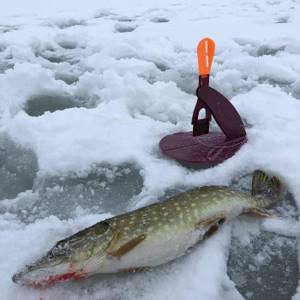
Fishing for pike on girders: how to fish correctly and catch a trophy
Read more
Balancers
This type of artificial bait for pike fishing is used in winter and spring. They are caught with balance beams mainly from ice. It’s easy to select tackle for this, you will need:
- winter fishing rod with a hard whip;
- nod matched to the balancer;
- fishing line up to 0.2 mm thick, about 30 m;
- steel leash.
Fishing of the water area is carried out at wintering pits, the bait is given a different game:
- A simple twitch works effectively;
- you can lower it to the bottom, hold it for a minute and slowly raise it 15-20 cm.
It is important to understand what type of game attracts pike in a given body of water right now and continue to lure it in the same way.
The color range of the bait is very diverse; the angler’s arsenal should include acidic baits, options with sparkles, and more natural colors.
Catching pike on a balance beam
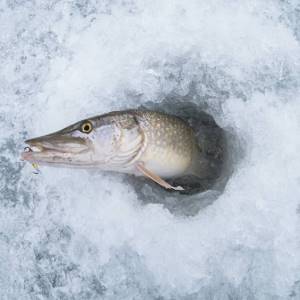
Fishing for pike on a balance beam in winter - choosing a place and time of fishing, fishing technique
Read more
Spoons
What else can you use to catch pike? What lures will attract her attention under the ice? Spinners will help catch a predator if there is one in the pond. Vertical options are most often popular; triangular models work especially well.
There are a lot of varieties of spinners; castmasters are the most popular among experienced fishermen; you can fish with them all year round. It is advisable to equip it with a high-quality tee through the winding ring.
In addition, homemade versions are often used on reservoirs, the secret of which is often kept secret by the craftsmen.
Pike on a spinner
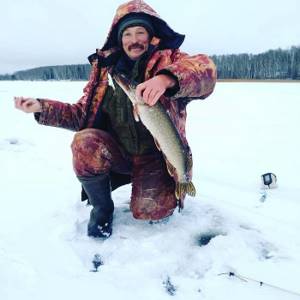
Catching pike with a spinner: subtleties of choice and correct placement of the selected bait
Read more
Rattlins
This type of bait is classified as wobblers; the peculiarity is that they do not have a shovel. The equipment on them is assembled according to the example of a balancer, but the leash is not always installed.
You need to play the rattlin in the same way as the balancer, only sharper. This bait will work best on the river; in stagnant water the effectiveness is much lower.
Rattlins for pike
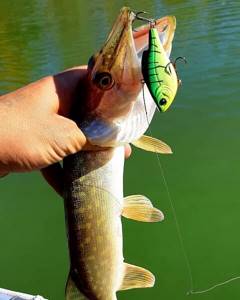
Rattlins for pike: rating of the best rattlins for summer and winter
Read more
Pike fishing in January
Unlike spring fishing, fish in winter do not ask to be caught in a net and require a certain patience and skill. When fishing this way, there are a number of nuances:
- When a fish bites on this or that bait, this does not mean that it was hooked. The process of fishing is important.
- During the fishing process, you need to properly loosen the fishing line. If the fish feels weak, it can easily free itself.
- If the hook is weak or the hook is not sharp, the predator can also easily free itself.
- At the moment when the fish is near the hole, it is better to use a hook so that the tackle does not break.
- If the fish is caught on a girder, then in frosty conditions it is better to use a bright flag when biting, which will rise when the fish hits it nearby.
- It is better not to fish when the wind is north or east.
Fishing technique
- Lure fishing can be done both from the shore and from a boat. If you prefer a boat, it would be better if there were two fishermen.
- It is important that the line is always perpendicular to the water.
- Playing with bait is performed at a depth of 70 centimeters from the bottom, but first you need to examine the hole where the predator is supposed to be.
- For trolling, short fishing rods with thin lines are used.
- Lures should be small in size.
- At the beginning of winter, predators like to attach themselves to forage fish that migrate from one depth to another. And here it is important not to stay in one place, but to look for schools of forage fish.
- You should look for fishing spots using an echo sounder, or you can drill several holes in different parts of the reservoir and wait for a bite.
- Since pike is a cautious fish, you need to approach the hole as quietly as possible.
- To catch a predator, you need to choose certain hours of the day, and this, as a rule, occurs in the morning.
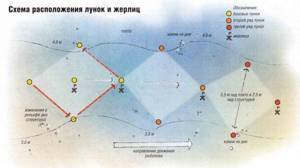
Features of pike fishing in January
In winter, catching pike is not so easy. Fishing is hardest in the middle of winter, especially if there are severe frosts. However, there are some positive aspects here:
- Lack of air weakens the state of the predator, and it resists less during fishing.
- Hunger forces the pike to leave its hatched holes and snags, and it rushes about in search of food.
- It is better to catch a predator in January with a regular fishing rod using crabs, poles or balancers. You can choose a fancy fishing rod for yourself, but you can get by with the simplest one - this will not affect the quality of fishing. The main thing is to choose a thin leash and a fishing line with a diameter of 0.3 mm.
- Hooking should be done quickly, because when the fish feels the balancer or other tackle, it may spit out the bait.
- The most popular baits are those whose flag goes up when bitten.
- When fishing, you should never allow the line to become loose, so as not to give the fish the opportunity to free itself.
- When the fish is near the hole, you should use waterproof gloves to avoid breaking the tackle.
- On sunny days it is worth canceling fishing, as there will be no bite on such days.
- The vents must be checked regularly, approximately every 10 minutes, and raised half a meter up. When the bait rises and falls, these movements provoke the pike to attack.
Video on catching pike in January on girders:
Fishing technique
Live bait used: small perches, roach, crucian carp and verkhovok. The pike in this reservoir gave preference to perch and crucian carp. Trophy perch and, in rare cases, ide might be interested in the verkhovka fish.
Therefore, we chose fishing tactics and techniques in a variety of directions and did not concentrate our attention on one type of fish.
What is the main technique for using a winter zherlitsa that works at this time of year?
Firstly, January is a cold month. Frost, which means the fish will be less active. The ice is already quite thick and in some places its thickness reaches 70 - 80 cm.
This means that oxygen enters the water in a minimal amount, which forces the fish to either be passive or look for sections of the river where the ice is thinner or has small thawed patches.
We were unable to find similar areas on the river, so we set up the girders in a checkerboard pattern. Some of the vents are located closer to the shore, the other part in deeper water areas, the so-called whirlpools.
I won’t describe what we caught, since we will only talk about tactics and will be interested in the arrangement of winter traps.
Fishing tips
- In clear water, the predator attacks baits that imitate forage fish. Wobblers with a silver color are more active.
- For muddy water in a pond, it is better to use bright baits that produce certain vibrations. This game allows the fish to see food faster.
- Some anglers use wobblers that resemble pike. It all comes down to the fact that she is a cannibal and is ready to pounce on such bait.
- It is worth paying attention to the availability of equipment.
- To be sure of the reliability of the leashes, you should make them yourself from high-quality materials.
- It is important to control your gear while fishing to prevent damage to the fishing line and other attributes.
- If fishing takes place from the shore, then you need to catch fish at short distances with subsequent casts.

